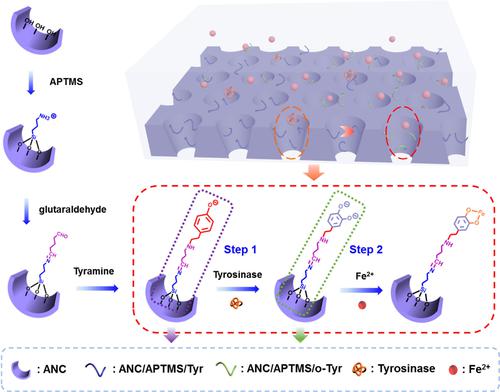当前位置:
X-MOL 学术
›
Electroanalysis
›
论文详情
Our official English website, www.x-mol.net, welcomes your
feedback! (Note: you will need to create a separate account there.)
Electrochemical Detection of Tyrosinase in Cell Lysates at Functionalized Nanochannels via Amplifying of Ionic Current Response
Electroanalysis ( IF 2.7 ) Pub Date : 2021-07-26 , DOI: 10.1002/elan.202100358 Lu Shi 1 , Zhihui Zhang 1 , Limin Zhang 2 , Yang Tian 2
Electroanalysis ( IF 2.7 ) Pub Date : 2021-07-26 , DOI: 10.1002/elan.202100358 Lu Shi 1 , Zhihui Zhang 1 , Limin Zhang 2 , Yang Tian 2
Affiliation

|
Tyrosinase is an important enzyme in the metabolism of melanin and catecholamine, as well as an important antigen in autoimmunity of vitiligo. However, it is still a challenge to develop a selective and sensitive sensing approach for monitoring of tyrosinase in cell environment. In this work, a sensing strategy based on ion current rectification induced by nanochannels was established to electrochemically detect inactive tyrosinase. Functionalized alumina nanochannels were decorated by tyramine as an electrochemical platform to selectively determine tyrosinase via chemically specific reaction between phenolic hydroxyl groups of tyramine and tyrosinase. On the other hand, Fe2+ was further bonded with dihydroxyl groups generated by tyrosinase in nanochannels to amplify charge changes, resulting in the enhancement on the detection sensitivity for tyrosinase. Based on this principle, the developed electrochemical sensor showed a good linearity towards tyrosinase from 2 to 50 U/mL with a detection limit down to 0.83 U/mL, which can fulfil the requirement for detection of tyrosinase in cells. Eventually, the present electrochemical sensor was successfully employed in the selective and sensitive determination of tyrosinase in cell lysates. The results suggested that the activity of tyrosinase in B16 cells was 1.7-fold higher than that of Hela cells.
中文翻译:

通过放大离子电流响应在功能化纳米通道上电化学检测细胞裂解物中的酪氨酸酶
酪氨酸酶是黑色素和儿茶酚胺代谢的重要酶,也是白癜风自身免疫的重要抗原。然而,开发一种选择性和灵敏的传感方法来监测细胞环境中的酪氨酸酶仍然是一个挑战。在这项工作中,建立了一种基于纳米通道诱导的离子电流整流的传感策略,用于电化学检测失活的酪氨酸酶。功能化的氧化铝纳米通道被酪胺修饰为电化学平台,通过酪胺的酚羟基与酪氨酸酶之间的化学特异性反应选择性地测定酪氨酸酶。另一方面,Fe 2+进一步与酪氨酸酶在纳米通道中产生的二羟基结合,放大电荷变化,从而提高对酪氨酸酶的检测灵敏度。基于此原理,研制的电化学传感器对酪氨酸酶的线性范围为2~50 U/mL,检测限低至0.83 U/mL,可满足细胞内酪氨酸酶的检测要求。最终,本电化学传感器成功地用于细胞裂解物中酪氨酸酶的选择性和灵敏测定。结果表明,B16细胞中酪氨酸酶的活性比Hela细胞高1.7倍。
更新日期:2021-07-26
中文翻译:

通过放大离子电流响应在功能化纳米通道上电化学检测细胞裂解物中的酪氨酸酶
酪氨酸酶是黑色素和儿茶酚胺代谢的重要酶,也是白癜风自身免疫的重要抗原。然而,开发一种选择性和灵敏的传感方法来监测细胞环境中的酪氨酸酶仍然是一个挑战。在这项工作中,建立了一种基于纳米通道诱导的离子电流整流的传感策略,用于电化学检测失活的酪氨酸酶。功能化的氧化铝纳米通道被酪胺修饰为电化学平台,通过酪胺的酚羟基与酪氨酸酶之间的化学特异性反应选择性地测定酪氨酸酶。另一方面,Fe 2+进一步与酪氨酸酶在纳米通道中产生的二羟基结合,放大电荷变化,从而提高对酪氨酸酶的检测灵敏度。基于此原理,研制的电化学传感器对酪氨酸酶的线性范围为2~50 U/mL,检测限低至0.83 U/mL,可满足细胞内酪氨酸酶的检测要求。最终,本电化学传感器成功地用于细胞裂解物中酪氨酸酶的选择性和灵敏测定。结果表明,B16细胞中酪氨酸酶的活性比Hela细胞高1.7倍。











































 京公网安备 11010802027423号
京公网安备 11010802027423号